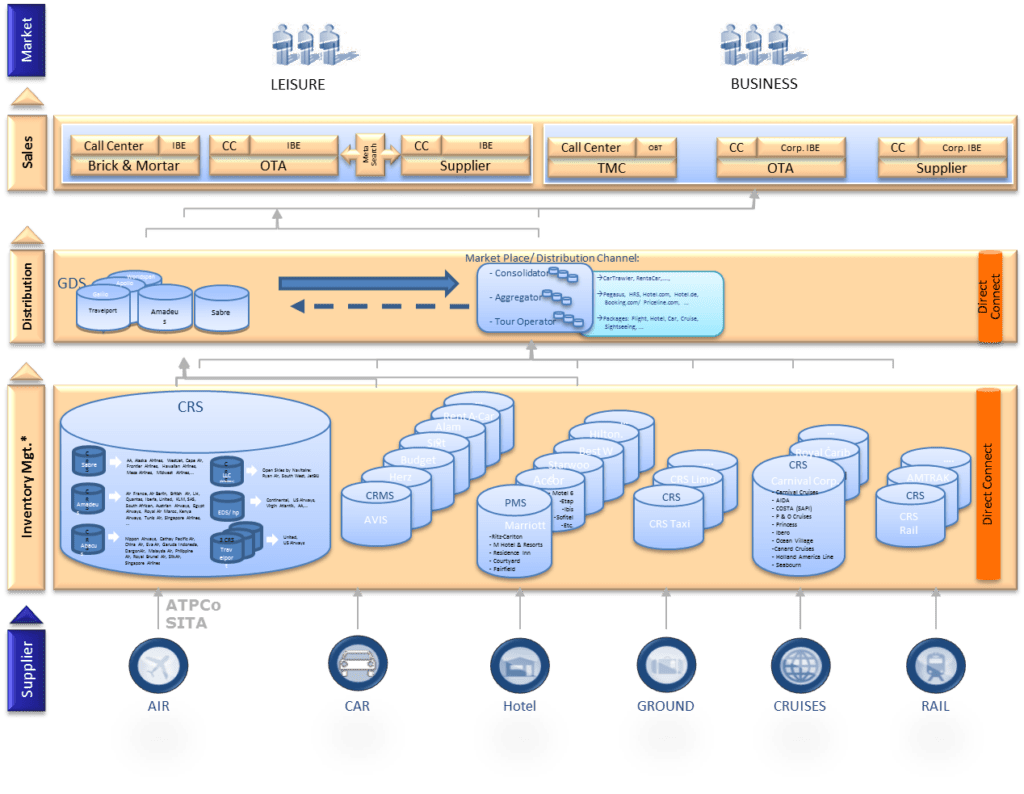The Passenger Service System usually comprises of the Central Reservation System (CRS), in other words booked inventory, an airline inventory system (free inventory) and a departure control system (DCS). It is basically the technology an airline needs:
- The CRS is the system that allows an airline to sell their inventory (seats). It contains information on schedules and fares as well as a database of reservations (or passenger name records) and of issued tickets.
- The airline inventory system may or may not be integrated with the CRS. The system contains all the airline’s flights and the available seats. The main function of the inventory system is to define how many seats are available on a particular flight by opening or closing an individual booking class in accordance with rules defined by the airline.
- The departure control system is the system used by airlines and airports to check in a passenger. The DCS is connected to the reservation system, enabling it to check who has a valid reservation on a flight. The DCS is used to enter information required by customs or border security agencies and to issue the boarding document. In addition, the DCS may also be used to dispatch cargo and to optimize aircraft weight and balance.
If we look at an image from my book Value Creation in Travel Distribution, we can see that a Passenger Service System (PSS) and in this respect the CRS and inventory management portion are part of a central technology piece for airlines:
Travel distribution landscape
- Supplier: airlines, hotels, car rental companies, etc.
- Inventory management: administration of the inventory in a CRS
- Distribution: usually Global Distribution Systems (GDSs), but also aggregators, consolidators and organizers
- Sales: End customers can arrange their travel purchase through the agency/TMC, one of the online agencies (OTA, OTMC) or even the provider directly on the corresponding website (direct).
- Market: the traveler or the company
The Underlying Technology
Still today, PSSs and especially the CRS portion of it are usually built on mainframes running the Transaction Processing Facility (TPF) operating system. However, providers of CRSs are also moving (at least in parts) away from such mainframes to allow for more flexibility, open source and cloud-based solutions (compare The Company Dime [paywall]). Those mainframes along with TPF are often referred to as “antiquated technology” in the travel industry, which may be the case, however, they are very reliable, secure and crazy fast. IBM invented this technology in the 1960s and besides airlines, it is still used by banks, retailers, and insurers – in any field that requires the handling of high volumes of transactions by a large number of users. The operation of such mainframes is expensive though: It is hard to find developers, there is no community of developers providing the services to the public for free and the price for the hardware itself usually has an additional digit. This is the main reason that companies are looking to replace such technology. We have even created automated migration technology to allow (in this case banks, but possible for travel systems as well) to migrate off such expensive technology.
Blog Series: Travel Technology for Dummies
- What Is Full Content?
- What Is a Booking Reference or PNR?
- What Is Overbooking?
- What Is a Passenger Service System (PSS)
- What Are Booking, Waitlists, Tickets, Codeshare & Interlining?
- What Are Active and Passive Segments?
- What Are Incentives, Commissions & Overrides?
- What Is a ‘Married Segment’?
- Blockchain in Travel: All You Need to Know – for Now
- What Is the Difference Between Fares, Rates and Tariffs?
- What Is NDC?
- What Is Continuous Pricing?
- What Is Direct vs. Indirect Distribution?
How to Change a Passenger Service System (PSS)
If airlines change their Passenger Service System (PSS), it is usually a huge undertaking of several years: Southwest, for instance, operated for the better part of 45 years with clumpy technology systems, mainly built in-house. It was generally a cheaper approach that better fit the needs of its network, radically different from those of hub-and-spoke airlines. However, it was lacking crucial flexibility and Southwest could e.g. not follow the general trend of charging for bags, as their system couldn’t be modified to allow ancillary services (did not prevent them from starting a marketing campaign around that for their advantage “bags fly for free”).
In a three years project for $ ½ million dollar, in 2015 Southwest decided to move to a special version of Amadeus’s Altea system as their PSS. Operations schedule to start in the first half of 2017, followed by additional enhancements later that year. New capabilities include: red-eye flying, which Southwest negotiated with its pilots in June 2012 but they haven’t been able to take advantage of these overnight flights to the East Coast and Midwest. Less-than-daily service, so that Southwest does not have to fly the same schedule Sunday-Friday to all the cities in its domestic network any longer, with a separate schedule only on Saturdays. Day-of-the-week tweaks, so that Southwest will be better able to adjust for Tuesday or Wednesday, when airlines tend to suffer from leaner demand. It will also put an end to the old information-technology plumbing, which did not adequately support the airline’s commercial efforts, such as selling early boarding or innovating around other ancillary revenue products.
In the merger of American Airlines and US Airways, the combined airlines switched to Sabre, which was a blow for HP as the old bankrupt American decided for one of the two systems currently supported by HP: AXRes (the former Attraxis system based on old Swissair PARS-based system) and the SHARES multi–host system. However, during chapter 11 proceedings the new American decided for SabreSonic.
Passenger Service System (PSS) changes can be disastrous or successful. United and Continental, combined in 2012, was considered an epic fail. American and US Airways are generally considered a huge success. Regardless, years of planning and preparation have to be taken into consideration.
But due to the fact that it is such a huge undertaking and risk to switch to a new Passenger Service System, it can be considered that providing the PSS to an airline is pretty much the license to print money. In the recent battle between airlines such as Lufthansa and GDSs, which are in most cases also the providers of the PSS, it remains to be seen if airlines can at all set themselves free or are locked into.
List of PSS providers
| Name | Vendor |
|---|---|
| AirCore | Unisys |
| Radixx International | Radixx |
| ACCELaero | Information Systems Associates FZE |
| Altéa | Amadeus |
| Crane PAX | Hitit |
| Zenith | Travel Technology Interactive |
| Open Skies / New Skies | Navitaire (acquired by Amadeus) |
| HP Agilaire / HP Shares (former EDS Shares) | HP |
| SabreSonic | Sabre |
| Horizon | SITA |
| ARCO | Alitalia |
| Travelport Meridian | Travelport |
| RESIBER | Iberia |
| Astral | Aer Lingus |
| Mercator (MARS) | Mercator (Emirates Airlines) |
| AeroCRS | Enoya-one LTD |
Picture credit: Shutterstock / vlad09






This Post Has 27 Comments
Hi Michael,
Can you please reply on this one?
Dear Michael,
Thank you so much for such an informative article. I have the following questions – if you could please elaborate on them
1. I understood the difference between PSS and GDS theoretically however I am still not sure how it works from Technology point of view. For example Altea is PSS from Amadeus, does that mean airline has to kind of but license of Altea from Amadeus and set it up in their infrastructure or Altea will be more of a SAAS model?
2. At the same time Amadeus is GDS as well which is more SAAS (software as a service), how does it help this airline in distribution as this airline does sell tickets online using Amadeus web services?
3. If possible, could you please explain difference between Amadeus e-Retail and Altea? I doubt that Amadeus e-Retail is GDS but only facilitates easy selling of tickets which are otherwise difficult using Altea since in that case you will have to integrate with numerous web services. Could you please validate my thinking? Also can you please confirm if Amadeus e-Retail is also SAAS?
4. If Amadeus e-Retail is not GDS and site is selling its tickets, how will I know if that airline used Amadeus as GDS or not? If I get to see this airline listings on skyscanner, is that good enough to assume that it uses GDS?
5. As you rightly mentioned that moving away from PSS is risky, if airline does want to use NDC, what does it mean from tools/products point of view? Does this mean that airline will still use Amadeus Altea and e-Retail but will not use Amadeus as GDS like closing its EDIFACT pipe? What all things to consider in this move?
6. As I am a software developer, if you could please help answer these in more technical terms or architecture diagrams, it will be very appreciated.
Thanks Again for such a wonderful article. Loved it very much.
Dear Karthik,
There are numerous articles about exactly this topic on my blog. Pls. feel free to utilize the search button. A couple of links:
– https://www.travel-industry-blog.com/gds/the-difference-between-crs-and-gds-in-the-travel-industry/
– https://www.linkedin.com/pulse/siemens-uses-amadeus-cytric-hook-altea-bypassing-gds-save-strauss/
– https://www.travel-industry-blog.com/travel-industry/ndc/
– https://www.travel-industry-blog.com/gds/multi-source-booking-tool-costs-and-restrictions/
And, I can also recommend my book “Value Creation in Travel Distribution” (http://www.amazon.com/author/strauss).
If you cannot find your answers there, pls. feel free to post them again here and I will do my best to answer them.
Thanks,
Michael
Dear Micheal,
As a new comer to travel industry, your blogs have been a great source of information to understand several fundamental concepts of the Travel world. Thank you so much for sharing this with the world.
Reading through the ‘Travel Industry Landscape’, I wanted to ask you the differences between GDS, Online Travel Agencies (OTA), Aggregators and Meta Search. It would be great if you can provide examples for each and help understand how these pieces are interconnected.
Thanks,
Karthik
Dear Jitender,
Thanks for your question. It appears indeed that married segments are nowhere really easily explained. Hence, instead of explaining it here, I took the liberty to explain it as its own blog article http://www.travel-industry-blog.com/travel-technology/married-segment/ along with stopover, layover, connection, stop and transfer.
Enjoy,
Michael
Sir, please make me understand what is married segment? Please, explain it as simple as you can. I’m from India.
Thanks
Thank you, pls. spread the word!
Dear Arun,
Thank you. I appreciate it. Pls. spread the word.
Thanks,
Michael
Hi Micheal,
Thanks for that great answer, you perfectly answered all the questions I had.
This blog is a like a gold mine of information on Air Trave Technology, enjoy reading it.
Best Regards.
Arun
Every industry is adopting new technology to improve its existence and traveled industry is not untouched with this. Every travel agent want to have Best tour operator software with them. Keep sharing about more technology in this industry. Great share.
Dear Arun,
I appreciate your kind words and will try to answer your questions:
Question: Inventory management, what exactly do you mean?
Answer: In the airline industry, available seats are commonly referred to as inventory. Inventory management is where the actual booking is hosted on behalf of the airline. This can be considered the real system, where there is one open spot for one seat on an aircraft. This inventory is handled by the Central Reservation System which is part of the PSS. In my new NDC article, I also have a set of pictures which may shed some additional light into the dark: http://www.travel-industry-blog.com/travel-industry/ndc/.
On a side note: the PSS inventory is influenced by the airline’s yield management to support a permanent optimization of the offered booking classes in response to changes in demand or pricing strategies of a competitor. It may also include overbooking strategies (http://www.travel-industry-blog.com/travel-technology/travel-technology-for-dummies-what-is-overbooking/).
GDSs mirror the inventory of all the airlines that they are allowed to distribute in their GDS system and thus have a pretty good overview of the truth of what is available, but in general (unless the co-operation between GDS and PSS supports access to the last seat in real time – called “last seat availability” or “last seat inventory”) not the full truth – as it is only a mirror and hence a cache. I’m sure you have experienced this when for instance you selected your seat on an Online Booking Tool that uses a GDS, you pay and all of a sudden, the system tells you that your seat is taken. This could have happened between your shopping and booking process, but much more likely the GDS cache was outdated.
Question: Do the airlines use GDS for inventory or the CRS?
Answer: The difference between a GDS and CRS is explained here: http://www.travel-industry-blog.com/gds/the-difference-between-crs-and-gds-in-the-travel-industry/. Airlines use the CRS as part of their PSS as their inventory management system. It is just as confusing because all of the major GDSs also ‘own’ a PSS and thus the distinction is not done correctly in many cases. A graphic of which company carries out which value creation step can be found in my book (https://amzn.to/mstrauss) as well as here: https://www.linkedin.com/pulse/siemens-uses-amadeus-cytric-hook-altea-bypassing-gds-save-strauss/. It doesn’t become easier when commercial aspects are included, such as the typical money flow for commission/overrides and tactics that airlines and GDSs may impose (http://www.travel-industry-blog.com/gds/multi-source-booking-tool-costs-and-restrictions/) – but that’s also a different topic.
Question: I read somewhere that different components of a flight search come from different systems for e.g. schedules come from OAG, seat availability from Airline CRS/GDS, and fares from ATPCo or GDS etc. Then, what exactly does this inventory management part do?
Answer: You are right about airlines filing fares with the Airline Tariff Publishing Company (commonly known as ATPCo). The users of ATPCo’s data indeed are the GDS such as Sabre, Amadeus, Travelport, along with their associated travel agents, but also Central Reservation Systems, online travel agencies (OTA) such as Expedia, Orbitz, and Travelocity and other service providers in the travel industry.
Also, OAG indeed has an airline schedule database which holds future and historical flight details, according to the company from currently more than 900 airlines and over 4,000 airports. I’m not sure who uses OAG and who doesn’t.
With NDC it may be that both fare filing and schedules will be handled by the airline itself again – which is a topic the GDS frequently bring up as a challenge for NDC: in a mixed configuration, where you have classical airlines using classical GDS interfaces and ATPCo fare filing, ticketing is handled by the GDS. In an NDC environment, in accordance with the question “Who is asking?” and tailored shopping results for the person requesting the flight, ticketing is handled by the airline.
With regard to inventory management, I hope I already answered this question above.
Let me know if these answers satisfy your great set of questions.
Thank you so much,
Michael
Hi Micheal,
Allow me to pass on my humble regards for the yeoman service you are doing to thousands of people who are out there in the dark by explaining so well the intricacies of travel technology.
I am a Business Analyst working for a travel technology company and yet I am unable to connect all the dots, part of it is to be blamed on the vastness of the topic.
Coming on to the topic now, when you say inventory management, what exactly do you mean? Do the airlines use GDS for inventory or the CRS? I read somewhere that different component of a flight search come from different systems for e.g. schedules come from OAG, seat availability from Airline CRS/GDS, and fares from ATPCo or GDS etc. What exactly does than this inventory management part does?
Regards,